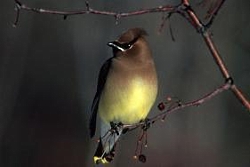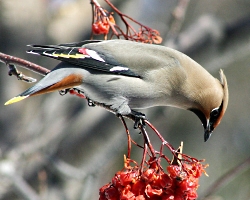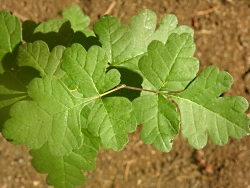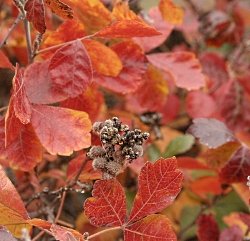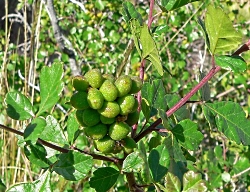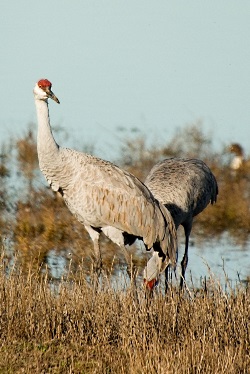
Grus canadensis
Courtesy US FWS,
Justine Belson, Photographer
George Archibald, who danced daily with a captive female whooping crane named Tex, provided a remarkable example of the biological significance of dancing cranes. George even slept beside Tex, huddled in a down sleeping bag through cold Wisconsin nights, to stimulate her egg laying activity. With the help of some sperm from a donor male crane, this technique proved successful, and George eventually became the proud godfather of a baby Whooper, which he appropriately named “Gee-whiz!”
I first became enamored with cranes while attending a lecture in the U.S. Library of Congress by author-naturalist Peter Mathieson. Cranes are ubiquitous in the earliest legends of the world’s peoples, where they often figure as harbingers of heaven and omens of longevity and good fortune.
Peter was a masterful story teller and soon had my students and I helplessly captivated. Our emotions vacillated from euphoric highs to abysmal lows with his elegant words describing this revered bird, the highs then snatched away as we learned of their tenuous existence. Of the 15 world species, 12 are in serious decline, primarily from habitat loss and overharvesting.
My appreciation for the magnificent avian species was accentuated last year when we had a guest presentation at our inaugural Cache Valley Sandhill crane festival in Logan. We soon realized that our guest speaker Paul Tebbel from Sacramento was more crane than human. Paul has spent much of his life both doing research as an advocate for the protection and enjoyment of this bird. From Paul we learned that the cranes elegant dance appears to go beyond mating to what can only be interpreted as a joyful expression of exuberance. Their dance continues in sporadic fashion throughout the year.
We also learned their read crown is not feathers, but skin which glows brighter with as its emotions escalate, a human trait. Another stunner came from discovering the lovely red earthen color of their feathers is actually a form of body art. The cranes will locate a reddish colored soil which they will use to preen with, transforming their natural gray plumage to an auburn glow.
On our field trip the following morning, we viewed several colts (crane youngsters) in the wet meadows and hayfields. Nesting begins early April to late May. Nests are usually low mounds of vegetation located in wetlands, but are occasionally located in uplands. The female typically lays two eggs, with incubation lasting 29 – 32 days.
Cranes are omnivorous and their diet varies depending on the season and where they are. Seeds, fleshy tubers of plants, grubs, earth worms, snails, amphibians, small reptiles and small rodents are all fair game.
Cranes typically travel 200 – 300 miles in a day during migration at speeds averaging 25 – 35 mph but can reach 500 miles with a good tail wind.
Among the oldest living birds on the planet a crane fossil found in northeast Nebraska is estimated to be about 10 million years old.
Fortunately, Sandhill Crane populations are stable to increasing. The total for the 5 subspecies numbers between 600,000 – 800,000, with Lesser Sandhill Cranes being the most abundant. Join us at our Sandhill Crane Festival in Logan June 10th & 11th to continue our celebration of these “Birds of Heaven” as described by Peter Mathieson.
This is Jack Greene reading for Wild About Utah.
Credits:
Image: Courtesy U.S. of the Interior, U.S. FWS, www.FWS.gov
Text: Jack Greene, Bridgerland Audubon Society & USU Office of Sustainability
Additional Reading:
Stillwell, Cindy, Mating for Life, https://cindystillwell.com/matingforlife/
A leading naturalist and writer travels the globe in search of a prized-and vanishing-bird
Cranes are ubiquitous in the earliest legends of the world’s peoples, where they often figure as harbingers of heaven and omens of longevity and good fortune. They are still held sacred in many places, and for good reason. Their large size and need for wilderness habitat makes them an “umbrella species” whose well being assures that of other creatures and of the ecosystem at large. Moreover, the enormous spans of their migrations are a symbol of, and stimulus to, international efforts at conservation.
In The Birds of Heaven, Peter Matthiessen has woven together journeys in search of the fifteen species of cranes in Asia, Africa, Europe, North America, and Australia. As he tracks them (and their declining numbers) in the company of scientists, conservationists, and regional people encountered along the way, he captures the dilemmas of a planet in ecological crisis, and the deeper loss to humankind if these beautiful and imposing creatures are allowed to disappear. The book includes color plates by renowned wildlife artist Robert Bateman.
https://www.savingcranes.org/george-archibald/
https://www.savingcranes.org/category/travels-with-george/
Ebersole, Rene, The Man Who Saves Cranes, Audubon.org, January 18, 2013, https://www.audubon.org/news/the-man-who-saves-cranes
Matthiessen, Peter(Author), Bateman,Robert, The Birds of Heaven: Travels with Cranes, North Point Press, 2001, https://www.amazon.com/Birds-Heaven-Travels-Cranes/dp/0374199442
https://www.fws.gov/uploadedFiles/Region_5/NWRS/Central_Zone/Montezuma/SandhillCraneFacts.pdf
https://www.fws.gov/refuge/Columbia/Wildlife_Habitat/Sandhill_Cranes.html
https://www.fws.gov/uploadedFiles/Region_1/NWRS/Zone_2/Mid-Columbia_River_Complex/Columbia/Documents/sandhill-crane-facts.pdf
https://www.fws.gov/news/ShowNews.cfm?ID=35C68BA1-DB0A-B16D-9BD2623AAD48D3FD





